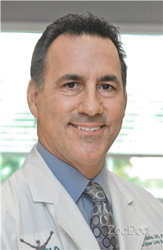
Dr. Alejandro Badia
Unless your injuries are life or limb-threatening like those of Tiger Woods, then the hospital is not the place to be.
MIAMI (PRWEB)
March 26, 2021
“I don’t want to have to take you to the hospital if you fall” may be a mother’s lament to a rambunctious child, but “it is precisely that kind of message which has us unnecessarily going to a hospital emergency department for treatment of the simplest of injuries,” according to orthopedic surgeon Alejandro Badia, MD, founder and chief medical officer of the Florida-based Badia Hand to Shoulder Center and OrthoNOW®.
“Unless your injuries are life or limb-threatening like those of Tiger Woods, then the hospital is not the place to be,” says Dr. Badia, a renowned specialist in musculoskeletal disorders, deformities, and injuries of the upper limb. He was referring to Woods’ February 2021 motor vehicle crash, which left the pro golfer unconscious and crushed his right leg, ankle, and foot, causing multiple, complex bone fractures and soft tissue injuries.
“In fact, a trip to the hospital ER rather than to an orthopedic specialty center or orthopedist’s office for treatment of a sprain or non-life-threatening bone fracture will likely result in extensive waiting time, unneeded testing, much higher costs and, in the end, a referral anyway to an orthopedic surgeon for follow-up care,” says Dr. Badia.
Even more of a concern to Dr. Badia than patient time and money is patient safety. “Oftentimes, hospital emergency departments do not have orthopedic specialists immediately available, leaving emergency medicine physicians the task of diagnosing and treating a musculoskeletal problem for which they have limited knowledge and clinical experience,” he notes.
Experts concur.
Authors of a study discussed at the 2016 annual meeting of the Society of Military Orthopaedic Surgeons concluded that a “significant number” of orthopedic conditions seen at some Level I trauma centers are “misdiagnosed and ineffectively managed.” Nearly 40 percent of the 239 emergency ortho consultations reviewed were considered inaccurate because they were too general, incomplete, contained wrong terminology, or, in more than 11 percent of cases, deemed “grossly inaccurate,” investigators said.
The same is true for children. At an American Academy of Pediatrics National Conference & Exhibition, University of Maryland researchers showed that more than 90 percent of “potential pediatric fractures” are incorrectly splinted by hospital emergency staff and by general physicians in non-orthopedic offices and settings. Improper splinting can lead to additional patient injury, including skin complications, excessive swelling, and failure to adequately immobilize the fractured bone, the scientists reported.
A “position statement” released by the American Academy of Orthopaedic Surgeons states clearly that “orthopaedic surgeons are the most qualified physicians to provide acute musculoskeletal trauma care and urgent general orthopaedic care.”
In an online, November 2019 Op-Med article, Dr. Badia writes that “it is not uncommon for a patient to present to me with wrist pain. While my experience and clinical [knowledge] often lead me to a diagnosis immediately by just listening to the patient’s complaints, the patient who [is sent] from a primary care doctor [or as referral from a hospital emergency department] may come to me with an MRI already performed, a battery of blood tests done, and, perhaps, even a course of physical therapy already in progress. The problem is that this patient may simply be suffering from tendinitis, which will respond to a single corticosteroid injection.”
Dr. Badia blames inappropriate and overtreatment of musculoskeletal problems in the ER on:
- Convenience — hospital ERs are open 24/7.
- Recommendations from primary care physicians that patients with presumed orthopedic injuries go to the nearest hospital.
- The current scant presence of Orthopedic urgent care centers in select cities which provide expert specialty care with NO appt needed.
•Physician concerns that more, rather than fewer, diagnostic tests are necessary to avoid liability.
- Lack of non-specialists’ experience in treating orthopedic injuries.
Indeed, a survey conducted a few years ago by the Network for Excellence in Health Innovation indicates that as many as half or more or all hospital emergency visits — which exceed 140 million annually in the United States, according to the Centers for Disease Control and Prevention — are “potentially avoidable.” Some health and finance experts say ER costs can be as much as 10 times those of general and specialty urgent care centers.
“Pain alone is not the measure of a patient’s need for immediate, emergency care,” Dr. Badia says. “True emergencies involve injuries like those sustained by Tiger Woods, namely, open fractures in which broken bones break through the skin, extensive bleeding, potential nerve involvement – numbness, tingling or weakness in the injured area, open wounds, or trauma to the head, neck or spine.”
For patients who experience relatively minor orthopedic injuries during sports activities, do-it-yourself projects, or falls, Dr. Badia offers these tips:
- Control pain and swelling of the injured joint or limb by immediately applying ice to it, elevating it, and resting it.
- If available, use a wrap or elastic bandage around the injured area to compress it and further limit swelling.
- Take an over-the-counter pain medication.
- If swelling and pain do not diminish after 24 or 48 hours, contact an orthopedic specialist or go to an orthopedic urgent care center.
“The worst thing to do is delay treatment by assuming an injury will eventually clear up on its own. It likely won’t, and the delay may only worsen the problem. But don’t rush to the hospital. Go to an orthopedic urgent care center, such as OrthoNOW® or try to get an immediate emergency visit with your local orthopedic physician trained to treat orthopedic issues” Dr. Badia advises. Bio: Alejandro Badia, MD, FACS, is an internationally renowned hand and upper-limb surgeon and founder of Badia Hand to Shoulder Center and OrthoNOW®, a network of walk-in orthopedic centers. Dr. Badia is the author of Healthcare from the Trenches. http://www.drbadia.com http://www.orthonowcare.com
Share article on social media or email:

